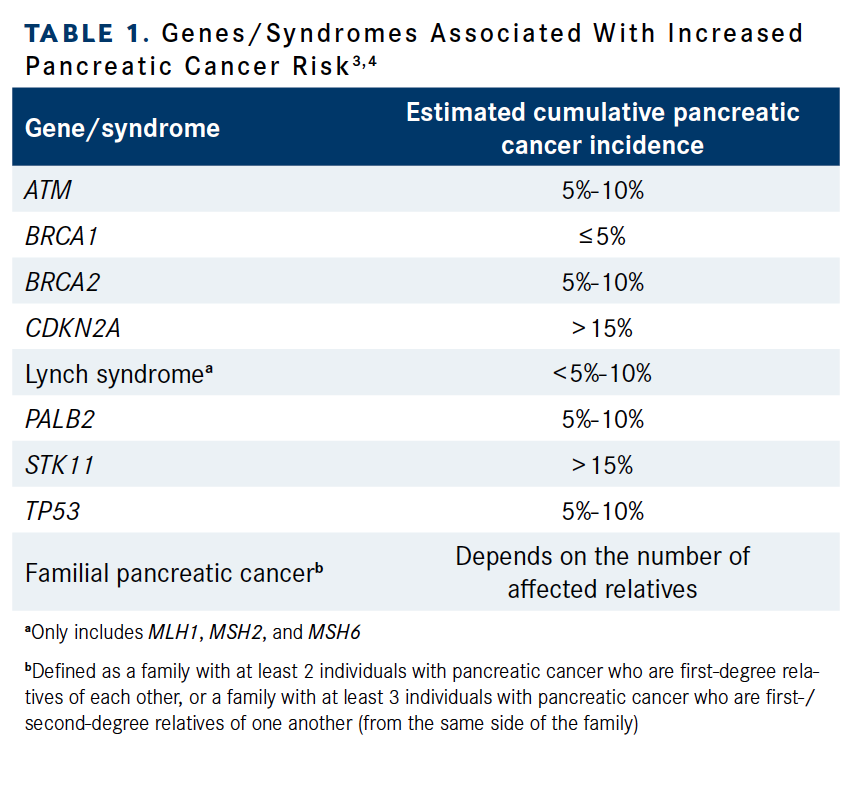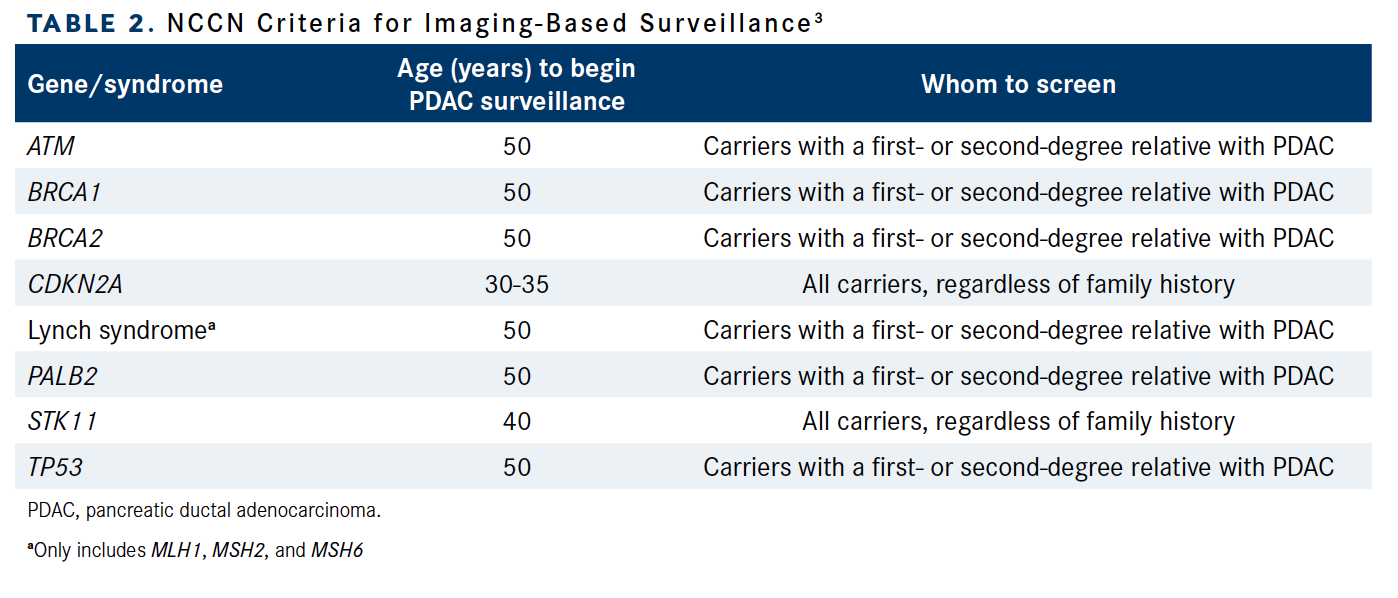Updates on Imaging-Based Pancreatic Cancer Surveillance for Individuals With Increased Genetic and Familial Risk
Recent years have brought tremendous progress in demonstrating that there is hope for improving mortality from pancreatic ductal adenocarcinoma through early detection.
Matthew B. Yurgelun, MD

Pancreatic ductal adenocarcinoma (PDAC) is a notoriously lethal malignancy, due in large part to the fact that it is often diagnosed once unresectable and/or metastatic. When PDAC is found at potentially resectable stages, however, long-term cure is increasingly possible, particularly with improvements in neoadjuvant and adjuvant therapies.1 Although they account for a relatively small fraction of all PDAC cases, those with stage I PDAC have particularly favorable outcomes, with recent data demonstrating 5-year overall survival rates of 83.7% and 74.3% for stage IA and IB PDAC, respectively.2 For individuals with known significant familial and/or germline risk factors for PDAC (Table 13,4), such data naturally raise the question as to whether surveillance and early detection of PDAC could help improve outcomes from this typically deadly malignancy.
Table 1. Genes/Syndromes Associated With Increased Pancreatic Cancer Risk.3,4

In recent years, there has been a growing body of literature investigating imaging-based PDAC surveillance using endoscopic ultrasound (EUS) and/or magnetic resonance cholangiopancreatography (MRCP) in those with significantly increased genetic and/or familial risk. These data have suggested at least a potential for such surveillance to detect PDAC at earlier, potentially resectable stages, compared with historical controls.5,6 Such encouraging findings are counterbalanced by the fact that cystic pancreatic lesions—mostly presumed side branch intraductal papillary mucinous neoplasms—are exceptionally common findings in this high-risk population, highlighting the very real potential for overtreatment of these otherwise low-risk lesions, especially given the significant anxiety often inherent to having significant genetic/familial PDAC risk.7,8 Additionally, with the relatively short-term follow-up in these early efforts, one reasonable critique was that the promising outcomes simply reflected lead-time bias, given the absence of unscreened control groups.
Most recently, the Cancer of the Pancreas Screening (CAPS) consortium analyzed prospective data from 1731 high-risk individuals undergoing imaging-based surveillance with MRCP and/or EUS, forming an aggregate of 5041 person-years of follow-up, which provided important longer-term insights into the potential benefits of such surveillance.9 These newest prospective CAPS data demonstrated an impressive “number needed to screen,” with 1 PDAC identified per year for every 194 high-risk individuals screened.9 Screen-detected PDACs were disproportionately early stage (58%, stage I; 16%, stage II) whereas PDACs diagnosed in study participants who had been lost to follow-up were not (86%, stage IV).9 Most critically, high-risk individuals with screen-detected PDAC had exceedingly good long-term outcomes with a 5-year overall survival rate of 73.3% (vs 0.0% for participants with PDAC diagnosed after being lost to follow-up) and median 9.8-year overall survival (vs median 1.5 years in those lost to follow-up; unadjusted HR, 0.13; 95% CI, 0.03-0.50).9
These data are still limited by the lack of unscreened control populations; however, these results seem to strongly refute the notion of lead-time bias being solely responsible for the very promising outcomes, given the massive difference compared with historical data. As such, guidelines from the National Comprehensive Cancer Network (NCCN) recommend imaging-based surveillance for many individuals with familial and/or genetic high risk for PDAC with annual MRCP and/or EUS (Table 2).3
Table 2. NCCN Criteria for Imaging-Based Surveillance3

However, several important questions remain regarding how to transform these successes from multicenter clinical trials into routine clinical care for individuals at risk for PDAC.4 One critical unknown is whether these promising outcomes can be replicated outside of a clinical trial setting. Both the performance and interpretation of MRCPs and EUSs can be quite specialized and nuanced, and the decision to monitor vs intervene on potentially worrisome imaging findings should ideally be made in the context of experienced multidisciplinary expertise that is not broadly available, which clearly limits the scalability of imaging-based PDAC surveillance and introduces the very real possibility of disparities in access to such care.
Another unanswered question is whether current criteria are too restrictive as to which high-risk individuals should be considered for imaging-based surveillance. For most of the variants and genetic syndromes that predispose to PDAC (ATM, BRCA1, BRCA2, PALB2, TP53, and Lynch syndrome), current NCCN guidelines recommend imaging-based surveillance beginning at age 50 years (or 10 years younger than the earliest PDAC in the family), but only if there is a known first- and/or second-degree relative with PDAC.3 This family history requirement is based on the fact that the various CAPS studies have only evaluated individuals with germline predisposition who also had a family history of PDAC, rather than any data conclusively showing that a family history of PDAC further increases risk.4 Some preliminary data have suggested that the yield of imaging-based PDAC surveillance may be comparable in individuals with germline PDAC risk who lack a PDAC family history vs what has been seen in those with a family history, raising the question as to whether all such individuals should be screened.10 To that end, recent clinical practice guidelines from the American Society for Gastrointestinal Endoscopy recently endorsed imaging-based surveillance for all individuals with pathogenic germline variants in BRCA1, BRCA2, and PALB2, regardless of family history (beginning at age 50 years), albeit as a “conditional recommendation” based on “very low quality of evidence.”11
Lastly, the intriguing question of how to use novel blood-based approaches to screening and early cancer detection looms large. Certainly, the hypothetical possibility of effective blood-based assay for PDAC surveillance would hold tremendous appeal and would certainly address the issues of scalability and subjectivity that are inherent to imaging-based surveillance. Various such assays are beginning to be studied,12 yet their ability to effectively, prospectively screen for PDAC in asymptomatic individuals (whether high or average risk) remains unproven. Currently, the use of such blood-based assays is not endorsed by NCCN guidelines or other professional societies for PDAC surveillance.3
In sum, recent years have brought tremendous progress in demonstrating that there is hope for improving mortality from PDAC through early detection. Although challenges and questions remain regarding how, where, and whom to screen for PDAC, the real-world successes from the CAPS studies and other such efforts provide well-justified optimism that we can continue to improve outcomes from this disease.
References
- Conroy T, Hammel P, Hebbar M, et al; Canadian Cancer Trials Group and the Unicancer-GI–PRODIGE Group. FOLFIRINOX or gemcitabine as adjuvant therapy for pancreatic cancer. N Engl J Med. 2018;379(25):2395-2406. doi:10.1056/NEJMoa1809775
- Blackford AL, Canto MI, Klein AP, Hruban RH, Goggins M. Recent trends in the incidence and survival of stage IA pancreatic cancer: a Surveillance, Epidemiology, and End Results analysis. J Natl Cancer Inst. 2020;112(11):1162-1169. doi:10.1093/jnci/djaa004
- NCCN. Clinical Practice Guidelines in Oncology. Genetic/ familial high-risk assessment: breast, ovarian, and pancreatic, version 3.2023. Accessed June 7, 2023. https://www.nccn.org/professionals/physician_gls/pdf/genetics_bop.pdf
- Yurgelun MB. Building on more than 20 years of progress in pancreatic cancer surveillance for high-risk individuals. J Clin Oncol. 2022;40(28):3230-3234. doi:10.1200/JCO.22.01287
- Canto MI, Almario JA, Schulick RD, et al. Risk of neoplastic progression in individuals at high risk for pancreatic cancer undergoing long-term surveillance. Gastroenterology. 2018;155(3):740-751.e2. doi:10.1053/j.gastro.2018.05.035
- Vasen H, Ibrahim I, Ponce CG, et al. Benefit of surveillance for pancreatic cancer in high-risk individuals: outcome of longterm prospective follow-up studies from three European expert centers. J Clin Oncol. 2016;34(17):2010-2019. doi:10.1200/JCO.2015.64.0730
- Canto MI, Hruban RH, Fishman EK, et al; American Cancer of the Pancreas Screening (CAPS) Consortium. Frequent detection of pancreatic lesions in asymptomatic high-risk individuals. Gastroenterology. 2012;142(4):796-804; quiz e14-15. doi:10.1053/j.gastro.2012.01.005
- Konings IC, Harinck F, Kuenen MA, et al; Dutch research group on pancreatic cancer surveillance in high-risk individuals. Factors associated with cancer worries in individuals participating in annual pancreatic cancer surveillance. Fam Cancer. 2017;16(1):143-151. doi:10.1007/s10689-016-9930-4
- Dbouk M, Katona BW, Brand RE, et al. The multicenter Cancer of Pancreas Screening study: impact on stage and survival. J Clin Oncol. 2022;40(28):3257-3266. doi:10.1200/JCO.22.00298
- Katona BW, Long JM, Ahmad NA, et al. EUS-based pancreatic cancer surveillance in BRCA1/BRCA2/PALB2/ATM carriers without a family history of pancreatic cancer. Cancer Prev Res (Phila). 2021;14(11):1033-1040. doi:10.1158/1940-6207.CAPR-21-0161
- Calderwood AH, Sawhney MS, Thosani NC, et al. American Society for Gastrointestinal Endoscopy guideline on screening for pancreatic cancer in individuals with genetic susceptibility: methodology and review of evidence. Gastrointest Endosc. 2022;95(5):827-854.e3. doi:10.1016/j.gie.2021.12.002
- Brand RE, Persson J, Bratlie SO, et al. Detection of early-stage pancreatic ductal adenocarcinoma from blood samples: results of a multiplex biomarker signature validation study. Clin Transl Gastroenterol. 2022;13(3):e00468. doi:10.14309/ctg.0000000000000468




